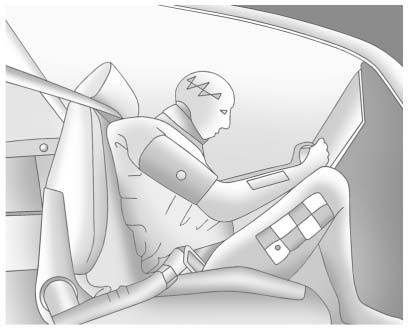Chevrolet Cruze Owners Manual: Safety Belts
This section of the manual describes how to use safety belts properly. It also describes some things not to do with safety belts.
WARNING
Do not let anyone ride where a safety belt cannot be worn properly. In a crash, if you or your passenger(s) are not wearing safety belts, injuries can be much worse than if you are wearing safety belts. You can be seriously injured or killed by hitting things inside the vehicle harder or by being ejected from the vehicle. In addition, anyone who is not buckled up can strike other passengers in the vehicle.
It is extremely dangerous to ride in a cargo area, inside or outside of a vehicle. In a collision, passengers riding in these areas are more likely to be seriously injured or killed. Do not allow passengers to ride in any area of the vehicle that is not equipped with seats and safety belts.
Always wear a safety belt, and check that all passenger(s) are restrained properly too.
This vehicle has indicators as a reminder to buckle the safety belts.
Why Safety Belts Work

When riding in a vehicle, you travel as fast as the vehicle does. If the vehicle stops suddenly, you keep going until something stops you.
It could be the windshield, the instrument panel, or the safety belts! When you wear a safety belt, you and the vehicle slow down together.
There is more time to stop because you stop over a longer distance and, when worn properly, your strongest bones take the forces from the safety belts. That is why wearing safety belts makes such good sense.
Questions and Answers About Safety Belts
Q: Will I be trapped in the vehicle after a crash if I am wearing a safety belt?
A:
You could be— whether you are wearing a safety belt or not.
Your chance of being conscious during and after a crash, so you can unbuckle and get out, is much greater if you are belted.
Q: If my vehicle has airbags, why should I have to wear safety belts?
A:
Airbags are supplemental systems only; so they work with safety belts— not instead of them. Whether or not an airbag is provided, all occupants still have to buckle up to get the most protection.
Also, in nearly all states and in all Canadian provinces, the law requires wearing safety belts.
- How to Wear Safety Belts Properly
- Lap-Shoulder Belt
- Safety Belt Use During Pregnancy
- Safety Belt Extender
- Safety System Check
- Safety Belt Care
- Replacing Safety Belt System Parts after a Crash
 Rear Seats
Rear Seats
Either side of the rear seatback can be folded.
To fold the rear seatbacks:
1. Place the front seatbacks in the upright position.
Notice: Folding a rear seat with the safety belts still fastened ma ...
 How to Wear Safety Belts Properly
How to Wear Safety Belts Properly
This section is only for people of adult size.
There are special things to know about safety belts and children. And there are
different rules for smaller children and infants. If a child will be r ...
Other materials:
Installation Procedure
Remove rear end upper panel extension (1) from service part.
Cut
Cut the body side inner panel in corresponding locations to fit the
remaining original panel. The sectioning joint should be trimmed to
allow a gap of one-and-one-half-times the metal thickness at the sectioni ...
SIR Disabling and Enabling
SIR component location affects how a vehicle should be serviced. There are
parts of the SIR system installed in various locations around a
vehicle. To find the location of the SIR components refer to SIR Identification
Views.
There are several reasons for disabling the SIR system, such as re ...
Ultrasonic Parking Assist
The Ultrasonic Rear Parking Assist (URPA) system assists the driver with parking
and avoiding objects while in R (Reverse). URPA operates at speeds less than 8 km/h
(5 mph). The sensors on the rear bumper detect objects up to 2.5m (8 ft) behind
the vehicle, and at least 20 cm (8 in) off the gr ...
